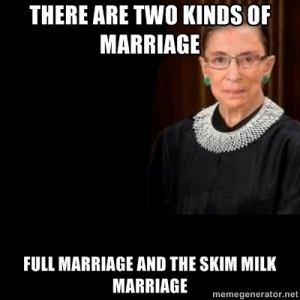 I did something last week I never thought I would do: I bought an American flag tank top. It was more than a surprise purchase; procuring that patriotic-chic garb signified both a personal mind shift and a collective new reality. Compulsory acts of consumerism may not seem like parallel signs of social progress, but in this case they are. This June will mark the first time that red, white, and blue—not the rainbow—will be my colors of choice!
I did something last week I never thought I would do: I bought an American flag tank top. It was more than a surprise purchase; procuring that patriotic-chic garb signified both a personal mind shift and a collective new reality. Compulsory acts of consumerism may not seem like parallel signs of social progress, but in this case they are. This June will mark the first time that red, white, and blue—not the rainbow—will be my colors of choice!
The rainbow flag has long been synonymous with gay pride celebrations. It’s understandable that we would want to have our own symbol of freedom. Liberty has often been an illusive concept for those of us who are LGBT. History, though, is being written more rapidly than most of us can write. The NBA has welcomed an openly gay player. The Boy Scouts are toying with entering the later half of the 20th century by allowing gay scout members. Three new states have passed marriage equality laws in a matter of weeks.
As progress abounds, it’s important to realize that only one scheme of colors has truly made this possible: those hues that are star spangled! Gay rights have galvanized support from much of the hetero-USA because of a long-evolving American tradition of us becoming a more perfect union by broadening the scope of who is “united” in the states of America.
I haven’t always felt so connected to my American heritage. I came of age in the era of George W. Bush, when the flag stood more for intimidation than it did liberation. After 9-11, it seemed as though everyone rushed to plaster their cars with American flag decals and decorate their bathrooms in patriotic motifs. A few ambitions folks even painted their houses with stars and stripes. Meanwhile, the government passed laws allowing our phones to be tapped, tortured people, and lied about why we were going to war. Those with flags on their cars were on the side of freedom; those without might just be terrorists…or so it felt!
I have always considered myself to be patriotic, but I usually prefer to act on my patriotism, not wear it. As I was involving myself deeper in politics, I become more offended by the brass assertion the administration in power was making that freedom really shouldn’t be afforded to everyone. It was nine years ago that Bush campaigned for re-election on the platform of amending the U.S. constitution to permanently ban gays and lesbians from marrying. Many of us in the LGBT community felt our country was turning against us. It’s an assault to one’s loyalty when the very framework that is supposed to protect rights is used as fodder for taking them away. Bush succeeded in using the issue to win re-election, but as eleven states voted to ban gay marriage in 2004, and more did so in years to follow, a funny thing happened. America got American on gay rights!
There have been thirty-six statewide campaigns centering on gay marriage. We’ve only won three of those referendums so far. The stinging defeats in the earliest years of this century have given way to a promise for later. Each time the issue has been put up for a vote, everyone in the state has been forced to have a conversation about not just gay marriage, but gay individuals. Many people have come out and many, many gay Americans have had difficult conversations with their friends, families, and colleagues as a result of these political fights. Discussion and deliberation are hallmarks of American democracy. So, too, is the freedom to change your mind–or evolve as it’s fashionably called now.
We still have a long way to go in becoming that more perfect union we strive to be. Even when we get there, the rainbow and its symbolic multi-hues of diversity will remain relevant. But we now have a first lady who tweets “we got your back” when a sports hero says that he’s gay instead of a president who wants to roll back the constitutional rights of LGBT Americans. And that’s exactly why I’ll be rocking my American flag tank top this month for pride!
